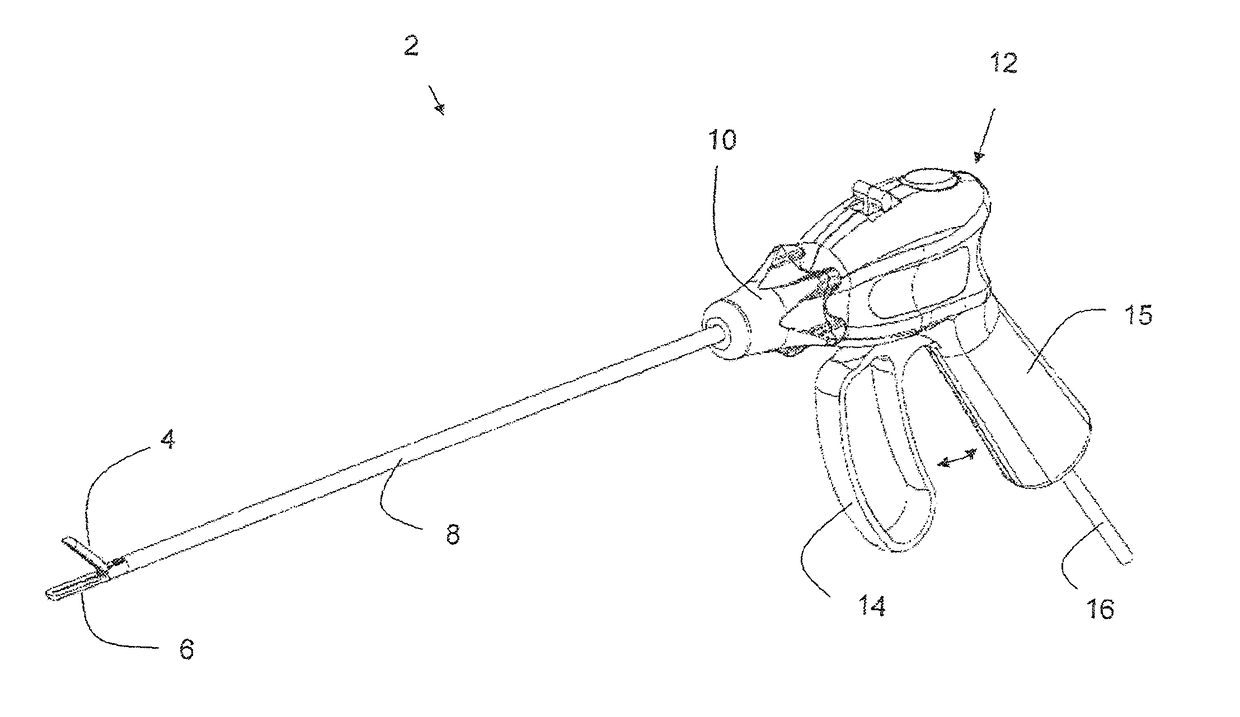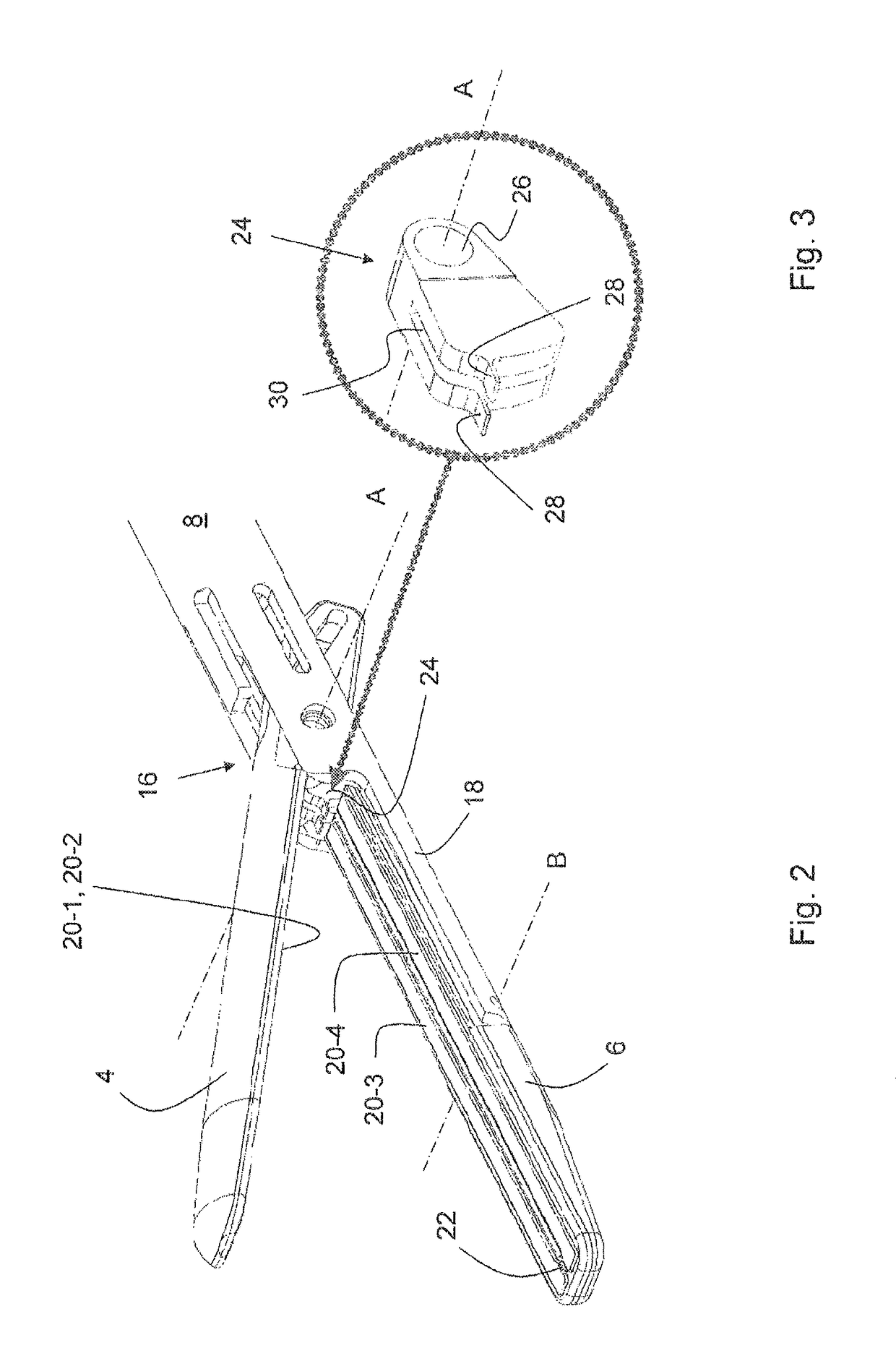Electrosurgical instrument and jaw part therefor
a surgical instrument and electrode technology, applied in the field of electrosurgical instruments, can solve the problems of inability to stably maintain the closed position of the leg spacing, risk that such non-conductive, nub-shaped protrusions can easily break off in use, and remain unnoticed, so as to achieve the effect of preventing coagulation shadows and gripping more reliably
- Summary
- Abstract
- Description
- Claims
- Application Information
AI Technical Summary
Benefits of technology
Problems solved by technology
Method used
Image
Examples
first embodiment
[0059]FIG. 1 shows a perspective view of a laparoscopic electrosurgical instrument 2 in open position according to the invention, comprising a jaw part consisting of a pair of instrument legs 4 and 6, which move relative to each other preferably in the manner of scissors or tongs, and are arranged on the distal end of an instrument shaft 8 which for its part is rotatably fastened to a handle piece or manipulation part 12 via a manually operable shaft rotation device 10. The shaft rotation device 10 allows to rotate the shaft 8 (and the instrument legs 4 and 6 arranged thereon) relative to the manipulation part 12 about the longitudinal axis of the shaft. The manipulation part 12 comprises a manually operable handle or trigger guard 14 which is able to move in pivoting manner relative to a handle or pistol grip 15 firmly connected to the manipulation part 12. The instrument legs 4, 6 or at least one manually operable instrument leg 4 are / is in operative connection with the handle 14 ...
second embodiment
[0070]In the second embodiment, two (nub-shaped) protrusions 32, 34 are immediately provided (i.e. firmly fixed) on the distal end portions of the electrode areas 20-3 and 20-4, instead of the protrusion 22 arranged between the electrode areas 20-3 and 20-4. In order to avoid a short-circuit between the electrode areas if these approach the electrode areas of the upper instrument leg 4 in the closed position, the protrusions 32, 34 are manufactured from an electrically conductive material and come to rest against a spacer abutment surface made of a non-conductive material which is provided on the respectively other of the opposing electrodes (exclusively) in the region of the respective protrusion (point- / pad-shaped). The protrusions 32, 34 may be applied by soldering or injection-molding or can be formed integrally (such as by embossing or stamping). The spacer abutment surface can be formed by injection-molding, spreading or filling in a hardening mass or by gluing or inserting an...
seventh embodiment
[0077]FIG. 17 shows an electrosurgical instrument 102 which differs from the instrument 2 described above in terms of the instrument type, in particular with regard to the construction of the operating device as well as the handle. Whereas all of the various embodiments described above have been described with reference to the laparoscopic electrosurgical instrument 2 illustrated in FIG. 1 comprising a thin, long shaft 12 and instrument legs 4 and 6 pivotally articulated thereon as a distal jaw part, the variants of the spacer arrangement which have been described above can also be realized in connection with the instrument 102 in which, however, two instrument legs 104 and 106 are connected to each other via a slide element 108 and a corresponding operation mechanism (not shown in further detail). With this arrangement, the handle or handle piece comprises a kind of accommodation duct from which the instrument legs protrude in axial as well as distal manner. This duct is dimension...
PUM
 Login to View More
Login to View More Abstract
Description
Claims
Application Information
 Login to View More
Login to View More - R&D
- Intellectual Property
- Life Sciences
- Materials
- Tech Scout
- Unparalleled Data Quality
- Higher Quality Content
- 60% Fewer Hallucinations
Browse by: Latest US Patents, China's latest patents, Technical Efficacy Thesaurus, Application Domain, Technology Topic, Popular Technical Reports.
© 2025 PatSnap. All rights reserved.Legal|Privacy policy|Modern Slavery Act Transparency Statement|Sitemap|About US| Contact US: help@patsnap.com



